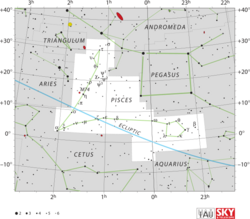Astronomy:Omicron Piscium
| Observation data Equinox J2000.0]] (ICRS) | |
|---|---|
| Constellation | Pisces |
| Right ascension | 01h 45m 23.63185s[1] |
| Declination | +09° 09′ 27.8530″[1] |
| Apparent magnitude (V) | 4.27[2] |
| Characteristics | |
| Evolutionary stage | Horizontal branch[3] |
| Spectral type | K0 III[2] |
| U−B color index | +0.736[4] |
| B−V color index | +0.959[4] |
| Astrometry | |
| Proper motion (μ) | RA: +72.98[1] mas/yr Dec.: +39.30[1] mas/yr |
| Parallax (π) | 11.67 ± 0.67[1] mas |
| Distance | 280 ± 20 ly (86 ± 5 pc) |
| Absolute magnitude (MV) | −0.22[2] |
| Details[5] | |
| Mass | 3.03 M☉ |
| Radius | 14.57 R☉ |
| Luminosity | 132 L☉ |
| Surface gravity (log g) | 2.57 cgs |
| Temperature | 5,004 K |
| Metallicity [Fe/H] | 0.10 dex |
| Rotational velocity (v sin i) | 2.88 km/s |
| Age | 390 Myr |
| Other designations | |
| Database references | |
| SIMBAD | data |
Omicron Piscium (ο Piscium, abbreviated Omi Psc, ο Psc) is a binary star in the constellation of Pisces. It is visible to the naked eye, having an apparent visual magnitude of 4.27.[2] Based upon an annual parallax shift of 11.67 mas as seen from the Earth,[1] the system is located roughly 280 light-years from the Sun. It is positioned near the ecliptic, so is subject to occultation by the Moon.[7] It is a member of the thin disk population of the Milky Way.[5]
The two components are designated Omicron Piscium A (formally named Torcular /ˈtɔːrkjʊlər/)[8] and B.
Nomenclature
ο Piscium (Latinised to Omicron Piscium) is the system's Bayer designation. The designations of the two components as Omicron Piscium A and B derives from the convention used by the Washington Multiplicity Catalog (WMC) for multiple star systems, and adopted by the International Astronomical Union (IAU).[9]
The system bore the traditional name Torcularis septentrionalis, taken from the 1515 Almagest. The name is translated from the Greek ληνός ('full'), which was "erroneously written for λίνος" ('linen').[10] In 2016, the IAU organized a Working Group on Star Names (WGSN)[11] to catalog and standardize proper names for stars. The WGSN decided to attribute proper names to individual stars rather than entire multiple systems.[12] It approved the name Torcular for the component Omicron Piscium A on 5 September 2017 and it is now so included in the List of IAU-approved Star Names.[8]
In Chinese, 右更 (Yòu Gèng), meaning Official in Charge of the Pasturing, refers to an asterism consisting of Omicron Piscium, Eta Piscium, Rho Piscium, Pi Piscium and 104 Piscium. Consequently, the Chinese name for Omicron Piscium itself is 右更四 (Yòu Gèng sì, English: the Fourth Star of Official in Charge of the Pasturing.)[13]
Properties
This is a probable astrometric binary system.[14] The visible component, Omicron Piscium A, is an evolved K-type giant star with a stellar classification of K0 III.[2] At the estimated age of 390 million years,[5] it is most likely (76% chance) on the horizontal branch, rather than the red-giant branch.[15] As such, it is a red clump star that is generating energy through helium fusion at its core.[3] The star has three times the mass of the Sun and has expanded to over 14 times the Sun's radius. It is radiating 132 times the Sun's luminosity from its photosphere at an effective temperature of 5,004 K.[5]
References
- ↑ 1.0 1.1 1.2 1.3 1.4 1.5 van Leeuwen, F. (2007), "Validation of the new Hipparcos reduction", Astronomy and Astrophysics 474 (2): 653–664, doi:10.1051/0004-6361:20078357, Bibcode: 2007A&A...474..653V.
- ↑ 2.0 2.1 2.2 2.3 2.4 Setiawan, J. et al. (July 2004), "Precise radial velocity measurements of G and K giants. Multiple systems and variability trend along the Red Giant Branch", Astronomy and Astrophysics 421: 241–254, doi:10.1051/0004-6361:20041042-1, Bibcode: 2004A&A...421..241S.
- ↑ 3.0 3.1 Alves, David R. (August 2000), "K-Band Calibration of the Red Clump Luminosity", The Astrophysical Journal 539 (2): 732–741, doi:10.1086/309278, Bibcode: 2000ApJ...539..732A.
- ↑ 4.0 4.1 Jennens, P. A.; Helfer, H. L. (September 1975), "A new photometric metal abundance and luminosity calibration for field G and K giants", Monthly Notices of the Royal Astronomical Society 172 (3): 667–679, doi:10.1093/mnras/172.3.667, Bibcode: 1975MNRAS.172..667J.
- ↑ 5.0 5.1 5.2 5.3 Jofré, E. et al. (2015), "Stellar parameters and chemical abundances of 223 evolved stars with and without planets", Astronomy & Astrophysics 574: A50, doi:10.1051/0004-6361/201424474, Bibcode: 2015A&A...574A..50J.
- ↑ "omi Psc". SIMBAD. Centre de données astronomiques de Strasbourg. http://simbad.u-strasbg.fr/simbad/sim-basic?Ident=omi+Psc.
- ↑ Richichi, A. et al. (January 2016), "Lunar Occultations of 18 Stellar Sources from the 2.4 m Thai National Telescope", The Astronomical Journal 151 (1): 5, doi:10.3847/0004-6256/151/1/10, 10, Bibcode: 2016AJ....151...10R.
- ↑ 8.0 8.1 "Naming Stars". IAU.org. https://www.iau.org/public/themes/naming_stars/.
- ↑ Hessman, F. V.; Dhillon, V. S.; Winget, D. E.; Schreiber, M. R.; Horne, K.; Marsh, T. R.; Guenther, E.; Schwope, A.; Heber, U. (2010). "On the naming convention used for multiple star systems and extrasolar planets". arXiv:1012.0707 [astro-ph.SR].
- ↑ Allen, Richard Hinckley (1963), "Pisces, the Fishes", Star Names — Their Lore and Meaning, Dover, https://penelope.uchicago.edu/Thayer/E/Gazetteer/Topics/astronomy/_Texts/secondary/ALLSTA/Pisces*.html
- ↑ "IAU Working Group on Star Names (WGSN)". https://www.iau.org/science/scientific_bodies/working_groups/280/.
- ↑ "WG Triennial Report (2015-2018) - Star Names". p. 5. https://www.iau.org/static/science/scientific_bodies/working_groups/280/wg-starnames-triennial-report-2015-2018.pdf.
- ↑ "AEEA (Activities of Exhibition and Education in Astronomy) 天文教育資訊網" (in zh). 2006-05-19. http://aeea.nmns.edu.tw/2006/0605/ap060519.html.
- ↑ Eggleton, P. P.; Tokovinin, A. A. (September 2008), "A catalogue of multiplicity among bright stellar systems", Monthly Notices of the Royal Astronomical Society 389 (2): 869–879, doi:10.1111/j.1365-2966.2008.13596.x, Bibcode: 2008MNRAS.389..869E.
- ↑ Reffert, Sabine et al. (2015), "Precise radial velocities of giant stars. VII. Occurrence rate of giant extrasolar planets as a function of mass and metallicity", Astronomy and Astrophysics 574A (2): 116–129, doi:10.1051/0004-6361/201322360, Bibcode: 2015A&A...574A.116R.
 |


